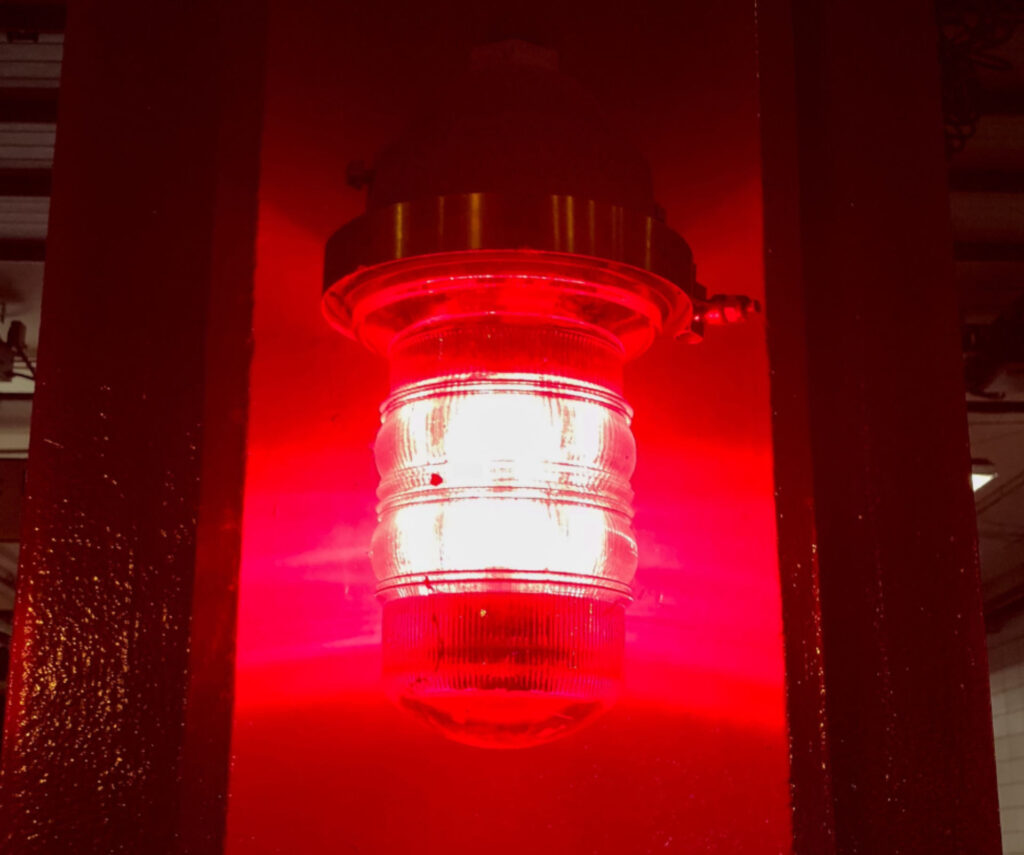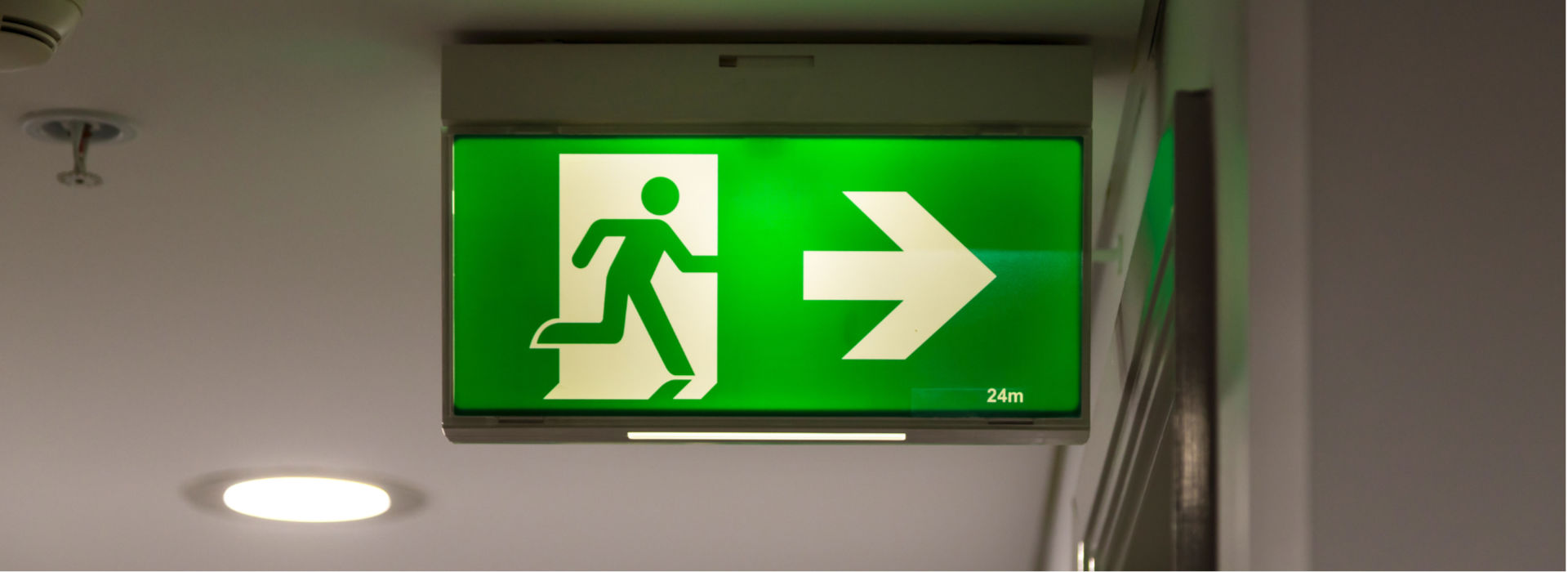Emergency lighting testing is a systematic process of inspecting, evaluating, and verifying the functionality of emergency lighting systems within buildings or facilities. These systems are designed to provide light when normal lighting fails during a fire, power cut, or other emergencies to assist in safe evacuation and emergency response. Such lighting systems include escape route lighting, anti panic lighting, and emergency exits.
Monthly and annual tests on such lighting systems can be crucial for a number of reasons, read on to discover the importance of regular testing for an emergency escape lighting system.
If your emergency escape lighting systems need testing, or you need emergency lighting installed, please contact us on 0800 669 6229 or through our online contact form to discuss your needs.

What Does Emergency Escape Lighting Testing Include?
Emergency lighting testing involves various tasks to ensure each aspect is functioning correctly, including:
- Functional Testing: Turning off the main power supply to simulate an emergency and ensure that the emergency lights activate as intended.
- Duration Testing: Verifying that the emergency lights remain illuminated for the specified duration, typically 1 to 3 hours, depending on local regulations.
- Battery Testing: Checking the condition and capacity of the backup batteries to ensure they can power the lights adequately during emergencies.
- Luminance Measurement: Assessing the brightness of the emergency lights to ensure they meet required illumination levels.
- Visual Inspection: Examining the physical condition of the lights, including bulbs, fixtures, and signs, to identify any visible defects or damage.
- Records Keeping: Maintaining detailed records of testing dates, results, and any maintenance or repairs performed.
Benefits of regular testing
Ensuring Safety Compliance
In the realm of safety compliance, it’s crucial that you conduct regular tests on your emergency lighting systems to ensure they’re functioning optimally. These systems are your lifeline during emergencies; you can’t afford any glitches. Regular checks help you spot and fix issues before they turn into major problems.
This isn’t just about ticking off a box in a compliance checklist, it’s about ensuring safety. It could be a matter of life and death during an emergency situation. It’s your responsibility to make sure everything works smoothly when it’s needed most.
Fault Detection and Troubleshooting
When it comes to fault detection and troubleshooting, you’ll find regular testing to be crucial for your emergency lighting system. This testing allows you to identify and rectify any faults before they become a risk. It’s not just about ensuring the lights come on during a power outage, but also checking battery life, circuit integrity, and overall system performance.
Running these checks regularly means you’ll spot any issues early, giving you time to fix them. Troubleshooting becomes a proactive, rather than reactive, process.
A faulty emergency lighting system isn’t just a minor inconvenience – it could be a serious safety hazard. So don’t skip the tests. They’re the best way to keep everything working as it should.
Legal and Regulatory Requirements
Regularly testing your emergency lighting systems not only ensures safety but also makes sure you are meeting important local authority requirements. Various laws mandate frequent testing and maintenance of these systems. Non-compliance can result in hefty fines, legal actions, and even business closure, as it’s part of your legal duty to keep your premises safe for everyone.
Insurance companies often require proof of regular testing before they cover any fire-related damages. So, stay on top of your responsibilities and ensure your emergency lighting systems are always in good order.
Cost-Effective Maintenance
Beyond meeting legal obligations, regular testing of your emergency lighting systems can also save you a significant amount of money in the long run. It’s a preventive measure that helps you identify potential problems early before they escalate into costly repairs or replacements.
Consistent testing and maintenance can actually extend the lifespan of your systems, reducing the need for new installations. By keeping them in good working order, you’re also minimising the risk of system failures that could result in hefty fines or liability issues. Plus, it’s generally more affordable to conduct routine tests and perform minor fixes, than to deal with the consequences of a major system breakdown.
Extended Equipment Lifespan
Regular testing of your emergency lighting systems also significantly extends their lifespan. Just like any other equipment, these systems wear out over time. With regular testing, you can prevent systems from failing prematurely.
Moreover, regular maintenance ensures that all components are in optimal condition. In the long run, this not only saves you from unexpected costs but also guarantees a longer lifespan for your emergency lighting systems.
Maintained Emergency Lighting Systems
Regular testing of your emergency lighting systems is crucial for safety compliance, efficient fault detection, and meeting legal requirements. It’s also a cost-effective maintenance strategy that extends your equipment’s lifespan.
At Cooper Weston, our expert team is able to conduct emergency lighting system checks to ensure that everything is always up and running in case of emergency. If you’re in need of our services, give us a call on 0800 669 6229 our team will be happy to help.
Scalability
One of the key advantages of structured cabling is its scalability. By installing data cables, you’ll be able to seamlessly expand and integrate new network devices and technologies as your business grows and develops.
When your business grows or needs to add more devices to the network, structured cabling allows for easy integration. You can simply connect new devices to existing ports or add additional cabling runs without the need for a complete infrastructure overhaul.
Enhanced Performance
Structured data cabling optimises network performance in a variety of ways:
Reduced Signal Interference
Structured cabling systems are designed to minimise signal interference, also known as crosstalk. This interference occurs when electrical signals from one cable interfere with signals in adjacent cables. Structured cabling separates data and voice cables, power cables, and other sources of interference, reducing the risk of data degradation or loss.
Consistent Data Transmission Speeds
Data cabling provides consistent data transmission speeds across the network. With properly installed and maintained cabling, you can achieve the maximum data transfer rates supported by your networking equipment. This consistency is crucial for businesses that rely on real-time data processing and high-speed connectivity.
Lower Latency
Latency refers to the delay in data transmission. Structured cabling minimises latency by providing a direct and efficient path for data to travel between devices. Low-latency networks are essential for applications like video conferencing and financial transactions, where real-time response is critical.
Reliability
A well-structured data cabling design enhances network reliability. By reducing the risk of cable failures, loose connections, or signal disruptions, structured cabling helps ensure that your network stays up and running consistently. This reliability is particularly important for businesses that require 24/7 connectivity and minimal downtime.
Easy Troubleshooting
When issues do arise within a network, structured cabling simplifies the troubleshooting process. Each cable and connection point is labelled and organised, making it easier for IT professionals to identify and resolve problems quickly.
Support for High-Bandwidth Applications
With the increasing demand for bandwidth-hungry applications and technologies, such as 4K video streaming, cloud computing, and IoT devices, structured cabling ensures that your network can support these high-bandwidth requirements without performance bottlenecks.
Longevity
Structured cabling systems have a longer lifespan compared to ad-hoc or disorganised cabling solutions. They are designed to accommodate future technology upgrades and evolving network standards, helping your business stay competitive without the need for frequent infrastructure overhauls.
Cost Savings
Investing in structured data cabling can lead to significant cost savings over time. The streamlined, well-organised infrastructure reduces the need for frequent repairs and upgrades, ultimately lowering maintenance costs and increasing the lifespan of your network.
Data cabling also minimises the cost of expanding your network. Instead of investing in a complete cabling overhaul each time you need to add devices or locations, you can make incremental changes, resulting in cost savings over the long term.
Future-Proofing
As technology continues to advance, structured data cabling future-proofs your infrastructure. It can support the latest technologies, such as high-speed data transfer and emerging communication protocols, ensuring your business remains competitive and adaptable.
It can support various networking technologies and standards, including Ethernet, fibre optics, and emerging high-speed protocols.
Data Cabling Installation Services
A structured cabling system is not just a wiring solution; it’s a strategic investment that offers improved reliability, scalability, enhanced performance, cost savings, and future-proofing.
At Cooper Weston, we are an experienced data cabling company with an excellent reputation. If you think that data cabling services will aid your business, then please contact us on 0800 669 6229 to discuss your needs.







